Papers by Marlien Herselman

This article focuses on how the competence and capacity within the Faculty of Engineering and the... more This article focuses on how the competence and capacity within the Faculty of Engineering and the Built Environment, specifically the electronic/electrical discipline, at the Tshwane University of Technology is utilised to support Small Medium Enterprises (SME) as well as student development in a challenging industry environment where the emphasis is on producing innovative products which can serve South African communities. The outputs of innovative products and training provided by the Technology Station in Electronics (TSE), an initiative of the Department of Science and Technology (DST), and academic departments within the Faculty, will be highlighted. Other universities of technology, technology stations and industry can benefit from the challenges and lessons leamt by the TSE in supporting SME and student experiential training in South Africa. The TSE managed to increase SME support from 7 to 37 per annum over a period of 3 years and involved third-year electrical engineering students in 85 ofthe 87 projects with industry.

The use of Information Communication Technologies (ICT) within healthcare can make significant ch... more The use of Information Communication Technologies (ICT) within healthcare can make significant changes in the daily operations of hospitals particularly win the developing world. A technology assessment of five hospitals based within Nyanza Province in Kenya was conducted to find out how hospitals are embracing the use of ICT. Both primary and secondary data were collected to be used in the study. A qualitative study was used through the application of a multiple case study to investigate five randomly selected hospitals. Structured interviews, open ended questionnaires and observations were used as methods to collect data from the various hospitals. In order to collect relevant data the participants were divided into three categories. Managers (n=), hospital staff members (n=31) and patients (n=24). Therefore a total of (n=60), participated in the study. The findings revealed that just like in the majority of the developing nations, there are very few computers and e-health solutions that are currently used in the hospitals as a result of various challenges in Kenya. Consequently, this paper analyses the challenges and provide a way forward for developing nations when implementing e-health solutions.
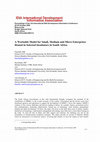
The South African Government, in line with international thought, recognises the potential of the... more The South African Government, in line with international thought, recognises the potential of the contribution of SMME's to the overall economy of the country. Government and the private sector have introduced agencies and operations to support the development of SMME's. Given this support, SMME's continue to face serious challenges and barriers leading to failure, for example, finance, government policy and communication, marketing, infrastructure, limited use of technology, weak business management, training and skills development. Of these, this paper will focus on the latter three areas of failure, namely, limited use of technology, weak business management and training, since these have a more direct bearing on the study. To stem the tide of failure and offer support and solutions, the challenge was met by the formulation of entrepreneurial incubation strategies. This paper provides an account of Maturity Models which are discussed in an historical context, reviewing past models, to trace the origins of such models.
In order to address chronic renal failure as a critical health problem in El Salvador (Central Am... more In order to address chronic renal failure as a critical health problem in El Salvador (Central America) a Living Lab (LL) methodology was applied to assist El Salvador to carry out research on low-cost techniques to mitigate exposure to pesticides and other chemicals in the environment, to improve the production processes and to improve the care of kidney patients in rural areas. This paper discusses and outlines the elements of LLs, and how these were applied to establish a LL in El Salvador to assist with creating risk awareness for risk mitigation to optimise the socio-economic, environmental and health situation in that country. The methodology applied in this paper is a qualitative approach with interpretation as theoretical underpinning and case study as the strategy.
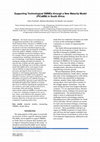
The South African Government has recognised the potential of the contribution of Small Medium Mic... more The South African Government has recognised the potential of the contribution of Small Medium Micro Enterprise's (SMMEs) to the overall economy of the country. Government and the private sector have introduced agencies and operations to support the development of SMMEs. Given this support, SMMEs continue to face serious challenges and barriers leading to failure, for example, finance, government policy and communication, marketing, infrastructure, limited use of technology, weak business management, inadequate training and skills development. To stem the tide of failure and offer support and solutions, the challenge was to develop a maturity model (PICaMM) which could support South African SMMEs in improving their business processes and improve their overall level of maturity as a developing organization. This paper will indicate how PICaMM can be applied by SMMEs to measure and improve themselves. After PICaMM was applied in two SMMEs through a mixed methodology approach results indicated that PICaMM did support these SMMEs to evaluate their level of maturity regarding the management of the workforce, new ideas, products and services, knowledge, skills and training. Maturity improvement within the SMME is evaluated along a 'step-wise' continuum of staged levels, one to five, where, at the fifth level the enterprise will be able to align its processes and activities with its business objectives to become more successful and competitive in gaining market share.

The main focus of this study was whether and how provision is made to enhance the quality of educ... more The main focus of this study was whether and how provision is made to enhance the quality of education in the Foundation Phase. After a case study investigation into a primary school and its view on quality assurance and interviews with the Department of Education: Eastern Cape province it became apparent that more research in to the q uality assurance aspect of primary schools is needed. The term "quality assurance" needs to be discussed and understood, and facilitators and managers at schools need to have a clear view of where they are going before ownership can be taken of teaching and learning. School principals should be in volv ed in the qu ality assuran ce process at all levels and facilitators should b e engaged in a process of self-evaluation in order to en sure quality in their teaching and learnin g. Certain quality assurance mechanisms and procedures should b e established at schools in order for all stakeholders to take responsibility for their own quality improvement, by being more accountable for their failures, to achieve the required results in their teaching.
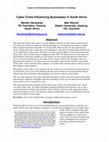
Journal of Issues in Informing Science and Information Technology, 2004
This study shows that cyber crime is a recent addition to the list of crimes that can adversely a... more This study shows that cyber crime is a recent addition to the list of crimes that can adversely affect businesses directly or indirectly. This phenomenon was not directly prosecutable in South Africa until the enactment of the ECT Act in July 2002. However this Act also prevents businesses to fully prosecute a hacker due to incompleteness. Any kind of commercially related crime can be duplicated as cyber crime. Therefore very little research appears or has been documented about cyber crime in South African companies before 2003. The motivation to do this study was that businesses often loose millions in cyber attacks, not necessarily through direct theft but by the loss of service and damage to the image of the company. Most of the companies that were approached for interviews on cyber crime were reluctant to share the fact that they were hacked or that cyber crime occurred at their company as it violates their security policies and may expose their fragile security platforms.
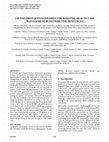
A tailored questionnaire focuses on dynamic generation of items and questions according to the lo... more A tailored questionnaire focuses on dynamic generation of items and questions according to the location where the questionnaire is used. The approach is connected to the management of resources and the support of decision making processes which is based on collecting data for a certain geographical region. The article shows how Geographic Information Systems (GIS) can be used to tailor a questionnaire to match the risk and demands of specific areas where the questionnaire will be applied. The GIS based generation of a questionnaire is used to provide tailored information for informed decision making in health care systems. Resource Management can only be optimized if the ICT-based representation is based on tailored information according to the area in which the process of optimization should be performed. Areas with a lack of resources and with heterogeneous environmental and social conditions should get a tailored response based on tailored information, which can be provided by th...
Applying a Mobile Human Computer Interaction (MHCI) view to the domain of education using Mobile ... more Applying a Mobile Human Computer Interaction (MHCI) view to the domain of education using Mobile Learning (Mlearning), the research outlines its understanding of the influences and effects of different interactions on the use of mobile technology in education. This research therefore evaluates specific mlearning projects, informed and directed from a MHCI perspective. The objective of this would be to highlight additional benefits, challenges, influences and effects of using mobile technology as an ICT in education. This investigation has led our research to suggest additional insights for MHCI and simultaneously provided a better understanding of the development and implementation of mobiles in teaching and learning.

The study focuses on e-procurement as government is currently in the process of transforming proc... more The study focuses on e-procurement as government is currently in the process of transforming procurement practices in line with national economic strategy. In order to address various socio-economic challenges, government is turning to technology to address issues such as outdated procurement practices. E-procurement promises the introduction of internationally accepted best practices to help government deliver on its mandate to its constituency. An in-depth background of South African legislation that governs the procurement practices in line with National Economic Development Initiatives is sought to give an insight into this paper. The paper explores how best Eastern Cape Provincial Administration can succeed in achieving the national and provincial socio-economic growth objectives. Reports and other primary sources of data were consulted, and expert interviews were conducted to answer this question. It was found that measurable benefits of supply chain management have not yet be...

This book is a representation of the activities, which were recognised as essential components to... more This book is a representation of the activities, which were recognised as essential components to be considered, when implementing a certain ICT4D initiative in a resource constrained area in the poorest province of South Africa which is faced with significant educational challenges. This intervention was coined the ICT4RED initiative and was a research, development and implementation project that changed the way in which teachers teach with technology in their specific context over a period of 3 years (2012-2015). The book aims to provide an overview of the design and implementation of an Information and Communication Technology for rural education development initiative in a resource constrained environment. Various frameworks, models, guidelines and tools were developed by adopting Design Science Research as the chosen methodology. Certain specific case study phases were applied within the Design Science Research process and lessons were learnt in each phase which was documented ...

2015 IST-Africa Conference, 2015
Business process adoption is one of the factors that determine an organisation's performance. Whi... more Business process adoption is one of the factors that determine an organisation's performance. While there are various factors that can have an impact on business processes adoption, this paper focuses on the impact of individual, process and organisational factors when adopting business processes in a large insurance organisation. Given evidence of non-optimal adoption, this paper investigates the factors that affect the adoption of business process by employees in insurance organisations in the context of Information Technology (IT) software development projects. A case study methodology was used with one large insurance company in South Africa as the unit of analysis. The data collection process started with conducting interviews with eight business process analysts to gain an understanding of how business processes are used in this organisation. This was followed by an online survey targeted at 120 business process users for which 65 responses were received. From the results of this study, a business process adoption (BPA) model has been developed which can be applied to assist an insurance organisation to improve the adoption of its business processes. The factors proposed in the model could guide future initiatives that aim to ensure the success of business processes in organisations.

A number of Small and Medium Enterprises (SMEs) in developing countries are slowly but steadily b... more A number of Small and Medium Enterprises (SMEs) in developing countries are slowly but steadily beginning to embrace the use of Information and Communication Technology (ICT). With such proliferation it is critical that the much anticipated positive impacts from such investments are realized. This has, however, not been true for many SMEs in developing countries, largely because a number of ICT solutions used within the SMEs do not adequately address their unique needs. As a result, many have ended up frustrated with their ICT investments. Our objective in this study was to build a snapshot on the impact of ICT used in SMEs in Eldoret, Kenya. Findings from this study reveal low positive impact of ICT on the SMEs. In the study, we identify factors that are responsible for the low impact of ICT on the SMEs and recommend actions that can be taken to ensure the adopted ICT brings positive change to the SMEs.

The Internet has made a considerable impact on how business is conducted. Empowered by technology... more The Internet has made a considerable impact on how business is conducted. Empowered by technology,customers are using the Internet to communicate and transact online. Small and Medium Hospitality Enterprises (SMHEs) within the tourism industrystand to benefit from using the Internet. However, SMHEs are noted for their failure to derive optimal benefits from using the Internet to improve their competitiveness. Internet technologies can be used to improve business efficiency or effectiveness (Buhalis and Law, 2008) and this can have a direct impact on an SMHE’s ability to compete. Necessitated by the importance of SMHE’s contribution in the economies of developing countries (Frempong, 2009), this paper highlights the ICT adoption challenges experienced by SMHEs, and identifies those Internet technologies which can be applied to the SMHE context. This study resulted in the development of a model to be used by SMHEs as a guide when making the decision to adopt technology. This model is ...
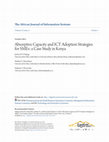
Many small and medium enterprises (SMEs) in developing countries continue to be challenged by the... more Many small and medium enterprises (SMEs) in developing countries continue to be challenged by their information technology (IT) adoption process, which is often characterized by a number of deficiencies. The purpose of this study was to examine the role of absorptive capacity (AC) in SMEs’ performance, as well as establish the correlation between SMEs’ AC and their IT adoption process. The findings of this study, obtained by measuring different dimensions of AC using Jimenez-Barrionuevo, Garcia-Morales, and Molina’s scale of 18 items, suggest that AC plays a critical role in the performance of SMEs in Kenya and that SMEs with strong AC employed the use of more superior IT adoption processes than did their counterparts with low levels of AC. The researchers submit that, if exploited, AC has the potential to improve the IT adoption strategies of SMEs in Kenya and those of other developing countries that operate within similar environments.






Uploads
Papers by Marlien Herselman